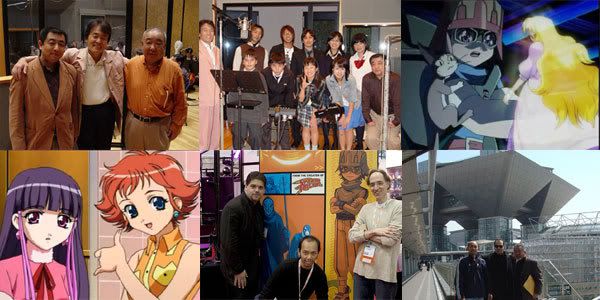While anime continues dealing with a core demographic which is growing ever younger, the amount of general ignorance of the basic methods of production and the finance of the anime we hold so dear is bound to manifest itself more often and in ways we the anime-enlightened (... ok "enlightened" my-ass, it's jaded not enlightened), find incredibly irritating and befuddling. Now to be fair, this kind of woeful lack of basic knowledge about an anime’s genesis has been around a long time and is not specifically exclusive to one specific age group. Listening to the various podcasts out there one can find misstatements and assumptions taken as fact from even the most (seemingly) experienced fan podcast with a large following. I sometimes find myself listening along and then reaching a comment or two, which by the commenter’s standards might seem a feasible occurrence or reasonable thing to say. But when it collides with the hard wall of factual reality it will just jump out as something so detached, that I have to count to ten and do 3 miles on the treadmill to avoid going into a Berserk-style slicefest on my i-pod out of sheer frustration induced rage.
So what is one to do about this seemingly spreading phenomenon? In all reality, there is nothing we can do but continue to extol the unattractive truth for those who wish to listen and learn. In doing so, I don’t expect to make many new friends as I may be shattering little bubble-worlds and dashing on hard rocks of reality the hopes and dreams of many a school aged otaku (weebo) who think they will have a career as the next Miyazaki or something. At the risk on engaging in the sort of behavior I recently wrote against in a previous post, I am going to go through the steps that I myself have gone through, as a small participant in the attempted production of an anime series, and detail the progress that those efforts made, getting almost to the finish line before exploding in a fire-storm of epic fail.
It was only a few years ago, when a Japanese producer had the idea to make another anime. Having so much experience in animation production, he was already more than a few steps ahead of absolute zero, and had this not been the case, such a project would have been over before it even got started. So remember kids anime production is one of those catch 22 businesses where in order to do it, you need to have already done it. The only way to get new blood into the fray is for it to attach itself in a remora-like fashion to what may or may not be a successful project lead by someone with previous experience. This is a tough industry to get into and an even tougher one in which to achieve recurring success.
So this opportunity comes along because my “home team” as it were, had an existing distribution contract with a third party distributor that had an impressive sales network in North America, and was also attached to a former major player in the toy/merchandise business which still had the occasional multi-million home-run a few times every decade. That sounds unimpressive, but when one considers the position of the other side of this equation (the Japanese producers approaching us in this project) which was more or less the same, meaning that they had already approached the power players in their league and had been rebuffed, such a combination of underdogs begins to make more sense now no?
So the stage is set, both parties are looking to someone to come in, fill the gap that would make the production an attractive investment, and then present the whole tempting package to financiers. The problem was that while one of these two halves of this newfound partnership was a well oiled machine, the other was a disaster waiting to happen, but that contingent could hold it off if funding came in for the short term. This meant that the “bait on the hook” could only stay in the water so long before falling apart. Both sides realized that there was only a small window to get some interested parties to the table in any case, and the courting began.

It was one fish in a sea of many to be sure, but what set it apart was that it was one of the only potentials out there specifically designed launch in the U.S., Japan, Europe (including U.K.) and Australia at the same time. So because of this, the news coverage of this endeavor was substantial in Asia, and the United States when you consider the PR was done more or less shoestring pro-bono, and press events were held both in New York and Tokyo (and a little one in L.A.).

Moving forward, a full pilot episode complete with opening and closing sequences was made at a cost of just under a few million dollars. It was screened in the U.S. and Japan, all the while the courting of finance company representatives continued in both cities. A promotional video with the series creator was filmed (but never released until much later) at the Tokyo Anime Fare in 2004. Reps from America came to Tokyo and did the rounds, and Japanese MITI reps even flew from Tokyo to New York several times to see the “American partner.” Things were looking good, but it was obvious that everyone who was brought in for the first round could not seriously be expected to bring in any investment capital. That was ok though, just “strike one”, and we had a lot more time at the plate... or so we thought.

Then it happened, the main name behind the project, the writer and producer, died. So; we had a pilot, music score, script, actual entire first episode completely done, designs, English and Japanese tracks recorded and ready to go…. All we needed was a broadcast deal and we were otherwise good to go for any financing out there. But losing the man behind it all made that insignificant. The Japanese contingent fell apart almost instantly, and took with it all the arranged studio deals, animation and voice obligations, certain rights, and just about anything else needed to get off the ground.
We tried to keep the momentum going, but without a burning core, a star does die. So the efforts and the hope we put into this project were all, in the end... wasted. The concept finally ended after becoming only one, 30 minute anime episode. In case you’re wondering where I am in all of this, well I’m behind the camera for most of these.
So what does this have to do with what was written at the start of this entry? It’s about the lack of understanding of the general knowledge of the multi million and sometimes multi billion dollar anime industry which leads people to believe things that are totally wrong. . After 10 years, The Angry Otaku got the chance to help pitch an anime, made by a man who has been making Japanese productions for over 50 years. It was solid. It was written well. It had a 30 minute pilot and more behind it, yet ran right into the wall (one day I’ll fan-sub that episode and let the internets see it. Or if anyone wants to fan sub it before me, then send me your JLPT score, and if yours is higher than mine, then better you than me).

So there you have it, in a very long and drawn out way I have simply stated that making an actual anime is not easy, it’s actually damn near impossible. Even if you have the basics, the chances of success are still against you. It is the fear of economic failure which leads to this gauntlet of trials and tribulations a concept must go through before it is thrown into production, and then after all that it has to be a profitable one. The fact that anime even exists as successful commercial enterprise on an international level is almost phenomenal in itself.
For a great many anime fans out there to act as if it is some sort of natural resource and will continue to flow unobstructed into the world as long as there is salt in the ocean shows that their understanding of why productions are made in the first place is sorely lacking. Yes, there is a very real detachment that causes one to think of anime as something that just appears at a click of a mouse, but this detachment then feeds uninformed assumptions about why things happen in the anime industry. Such assumptions formed by the misapplication or general knowledge to a pin-hole camera glimpse into a world that they themselves truly know nothing about simply from lack of experience.
For these people to say that “such and such” a company is doing “X“ action because of “Y” reason often smacks of such uninformed presumptuousness that it puts me off not only to hear it being said, but to know that it is being taken as fact by many others out there who simply do not know that such reasoning is extraordinarily unlikely. I have often thought of taking these instances on individually, and take the real risk of sounding like an anime know-it-all in an effort to try and simply give a better understanding of the very real business that anime fans have built a lifestyle around. However, in the end it is much better simply to march forward under the banner of “ignorance is bliss” and keep anime production something that is so often mixed with the realm of idealized imagination by people who don’t want to see it as a sterile impersonal industry, but rather as something simply positive and fun, or in the most extreme cases so life affirming that it takes on an almost religious quality in its importance.
So remember, the creation and distribution of what we hold dear is a commercial enterprise, and as such, the various private entities that operate with that enterprise often do not act in a very forthcoming way with information about why bad things happen. This leads to the time-honored and perfectly normal behavior of people using speculation to form opinions, but know this; the difference between an informed and uninformed opinion is not always easy to spot, nor is the damage it can cause easy to undo. In this era of failing economics, industry belt-tightening, the collapse of the American home video market, and the negative reaction of Japanese companies who are just now finding out that the reason their properties are so popular will not positively effect their earnings (don’t forget, that’s going to come with a nice big side order of resentment), the fan base is going to be watched more carefully and may have its greatest effect yet on the future of anime production as a whole. I’m not saying that it’s a good idea to stick your head in the sand, but please don’t panic, at least not until you’ve reached your own, informed opinion.















6 comments:
Do you know who produced the English dub, who produced the show, who animated it and if you have any footage from the English dub? Also do you know if you worked on it?
The dub was going to be done by High Wire Post on 54th st in NYC (now part of Media 451). I would have literally been in there.
Justin Sevakis was nice enough to reencode a version and put it up on his YouTube channel. https://youtu.be/muno09SjzpQ
Do you have a copy of the English dub of the pilot episode?
Do you have the opening and ending with English and Japanese credits?
It was never made.
Recording never commenced.
Post a Comment